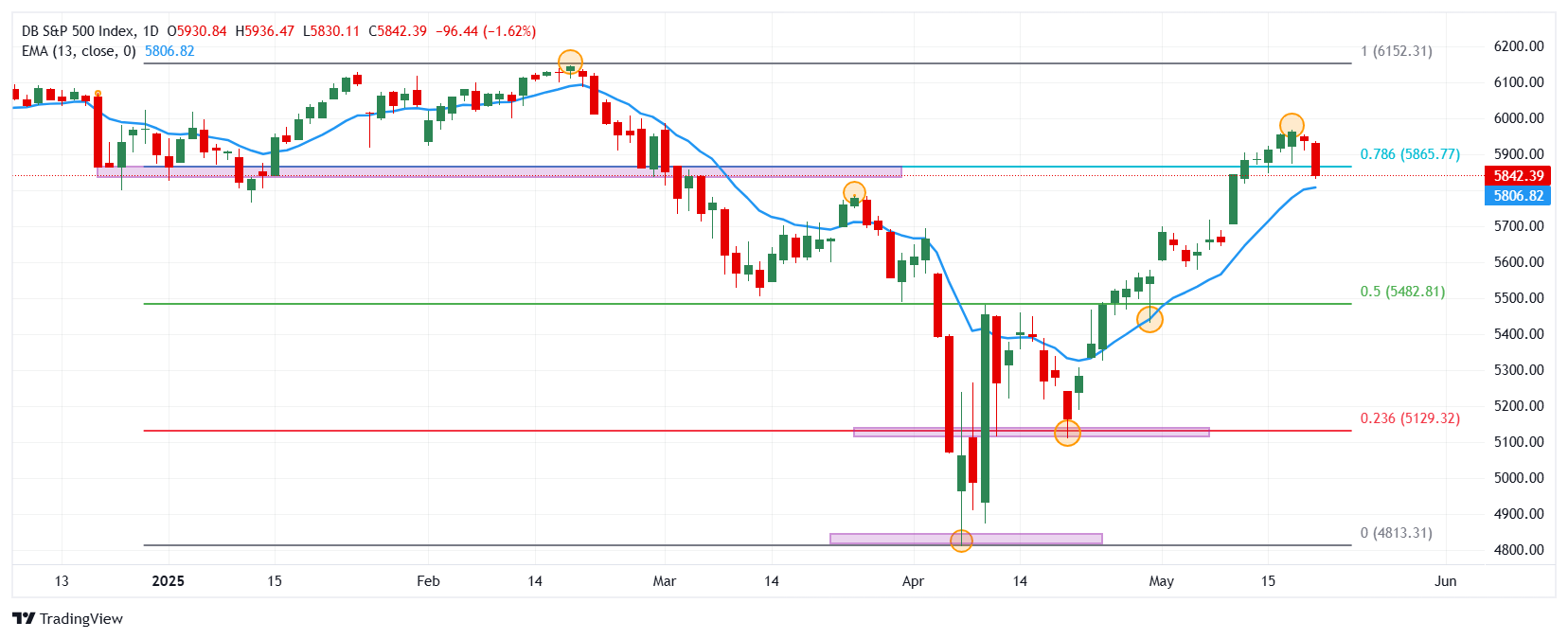- The S&P 500 share index decreases 1.62% on Wednesday, operating at the time of writing about 21,087.
- The titles of Fair Isaac Corporation (FICO) extend their losses and fall 15.74% daily, reaching minimum of April 8 in $ 1,658.
- The House of Representatives is preparing to vote the Fiscal and Budget Law Project proposed by the Republican Party.
- The United States economic agenda contemplates tomorrow the publication of the preliminary manufacturing, services and integrated May PMIS.
The S&P 500 registered a daily maximum in 5,936, finding vendors that dragged the minimum of May 13 in 5,830. Currently, the S&P 500 quotes at 5,842, falling 1.62% in the day.
The S&P 500 extends its losses and reaches minimum one week
The attention of investors has revolved to the vote of the Fiscal and Budget bill presented by the Republican Party, which is ready to add between 3 and 4 billion the United States federal budget deficit for the next 10 years. Similarly, fiscal deductions for natural persons who earn up to $ 500,000 are projected.
After being approved in the lower house, the bill will go to the US Senate for a final vote before the official firm of President Donald Trump.
In this context, the S&P 500 goes back 96 points, falling 1.62% today, reaching May 13 in 5,830, signing its second consecutive day down. Fair Isaac Corporation Fair (FICO) leads losses in the index, collapsing 15.74% daily, visiting April 8 in $ 1,658.
The US economic calendar considers the PMIS of Services, Manufacturing and Integrated Global S&P corresponding to May, to be published tomorrow.
Levels to be considered in the S&P 500
The S&P 500 reacted down from a short -term resistance in 5,936, Maximum of May 19. The next key resistance is located in 6,145, Maximum of February 19. Down, the important support is observed in 5,109, pivot point of April 21.
S&P 500 DAILY GRAPH

S&P 500 FAQS
The S&P 500 is a very often stock index that measures the yield of 500 public companies and is considered a wide measure of the US stock market. The influence of each company on the calculation of the index is weighted based on stock capitalization. This is calculated by multiplying the number of bought shares of the company for the price of the action. The S&P 500 index has achieved impressive yields: 1.00 $ invested in 1970 would have produced a yield of almost $ 192.00 in 2022. The average annual profitability since its creation in 1957 has been 11.9%.
Companies are selected by Committee, unlike other indices that are included based on established standards. Even so, they must fulfill certain eligibility criteria, the most important of which is stock market, which must be equal to or greater than 12.7 billion dollars. Other criteria are liquidity, domicile, stock capitalization, sector, financial viability, quotation time and representation of the sectors of the United States economy. The nine largest companies in the index represent 27.8% of the stock market capitalization.
There are several ways to operate with the S&P 500. Most of the Stred Betting retail runners and platforms allow operators to use contracts per difference (CFD) to make bets on the price direction. In addition, indexed funds, investment funds and quoted funds (ETF) that follow the price of the S&P 500 can be purchased. The most ETF liquid is the ETF of the London Stock Exchange. The most ETF liquid is the State Street Corporation Spy. The Chicago Mercantile Exchange (CME) offers futures contracts on the index and the Chicago Board of Options (CMOE) offers options, as well as ETF, ETF Inverse and ETF leverage.
There are many factors that promote S&P 500, but mainly it is the aggregate performance of the companies that compose it, revealed in their reports of quarterly and annual results. American and world macroeconomic data also contribute, since they influence investors’ confidence, which is positive drives profits. The level of interest rates, set by the Federal Reserve (FED), also influences the S&P 500, since it affects the cost of credit, which is largely depending on many companies. Therefore, inflation can be a determining factor, as well as other parameters that influence the decisions of the Federal Reserve.
Source: Fx Street
I am Joshua Winder, a senior-level journalist and editor at World Stock Market. I specialize in covering news related to the stock market and economic trends. With more than 8 years of experience in this field, I have become an expert in financial reporting.







